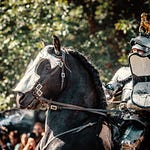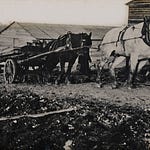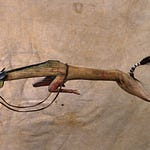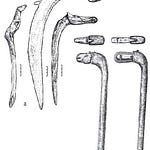In early human societies, horses played a significant role in agriculture, transportation, and warfare. Horses were used to transport goods and people, and served as a source of food and materials. Horses were able to carry heavy loads and plow fields, greatly increasing the productivity and efficiency of early farming communities.
The early nomadic tribes of the Eurasian steppes relied heavily on horses for their way of life, using them for herding, hunting, transportation, and even as a form of currency. As societies became more complex and hierarchical, horses also became symbols of wealth and status. Only the wealthy and powerful could afford to own and ride horses, making them an important indicator of social status. Horses were commercially traded and even used as military taxes: a certain number of cavalry was demanded as a tribute paid by the subdued societies to their conquerors.
The domestication of horses also had a significant impact on human conflict and warfare. Horses allowed for the development of cavalry, which became a critical component of many ancient armies. Utilizing the speed and mobility of cavalry units gave them a significant advantage over infantry. Historically, the ruling elites of most successful societies were also members of the cavalry and were skilled in horsemanship, such as the Equuites and Hippeis in ancient Greco-Roman societies, the Knights in medieval Britain or the Khans in the Mongol Empire.
For the past 4000 years, until the replacement of horses in warfare in the 20th century, the most successful societies and empires across the globe featured advanced cavalry as the backbone of their military might. Across the millenia, entire historical civilisations without horses and cavalry fell and were subdued under the waves of mounted conquerors, from Europe to China and Indian subcontinent, from ancient North Africa to the Columbine Americas.
Wild horses had disappeared from the Americas during the Ice-age, somewhere between 15,000 and 11,000 years ago. Horses, wild or domesticated, were completely absent in the early societies of the American continents, until horses were reintroduced to North America by the Spanish in the early 1500s. Initially, their presence was isolated to the Virgin Islands, but in 1519, Hernán Cortez brought more horses to Mexico where they thrived and migrated across North America. Horses rapidly transformed the life and culture of the Plains Indians, especially for hunting buffalo and warfare. Some indigenous people even consider horses as relatives and sacred medicine. European settlement of the Americas led to the declining importance of Central Asian nomads in cross-regional exchanges (the Silk Road) because trans-Atlantic contact and trade became more important.
Horses Brought Practical Advantages
Horses are often fast, strong and agile, but have some practical advantages beyond those attributes. Their prey instincts make them quick to panic, but are relatively easy to control. They need less sleep than most mammals (4-5 hours a day) and can get most of this sleep standing up – though they have to lay down for half an hour or so for deeper REM sleep. Importantly, they can be corralled or boarded in stables for reasonably long periods of time – a highly convenient feature efficient for herders, travelers, farmers, and warriors alike. Their meat, milk, and even blood, are highly nutritional sources of energy that can be used to support long-distance traveling. Their leather can be used to serve several purposes, such as to make resistant clothing or riding equipment. The nomadic tribes of horse herders typically moved across vast territories with large herds of horses, which were used as food supplies besides transportation. In warfare, horses enabled armies to move without needing supply lines, giving a mobile cavalry an advantage over ground troops that relied heavily on supply lines to support the movements of their armies.
The use of horses for transportation and warfare significantly increased the speed and efficiency of migrations during the Bronze Age. It increased the speed of travel, and horses could cover far greater distances than travel on foot. Horsemen could travel 15-20 miles per day or more, greatly expanding migratory ranges. Horses allowed migrants to transport food, supplies, weapons, stolen goods, etc. This supported longer journeys and enabled raiding and trading activities. Horses also expanded scouting and warfare capabilities. Mounted warriors could scout territories and engage in combat more efficiently than foot soldiers. This gave an advantage in warfare and conquest.
Horses improved communications. Messengers on horseback could quickly convey information and orders, coordinating migratory movements and military activities. Horses could transport the young, elderly or injured people who couldn't make long hard journeys on foot, increasing migratory capacity. The speed, maneuverability and elevated attacking position offered by horses gave mounted migrants/warriors a powerful psychological edge over footbound people. Horses allowed herders to move domesticated animals like sheep, goats, cattle over long distances to new territories.
Mounted travel revolutionized overland mobility and migratory capabilities. Journeys that would have been unthinkable on foot became feasible with horses. This transformed the speed and scope of how migrant groups could explore, conquer, settle and trade in new lands.












Horse Power | E05 | The Role of Horses in Human Societies